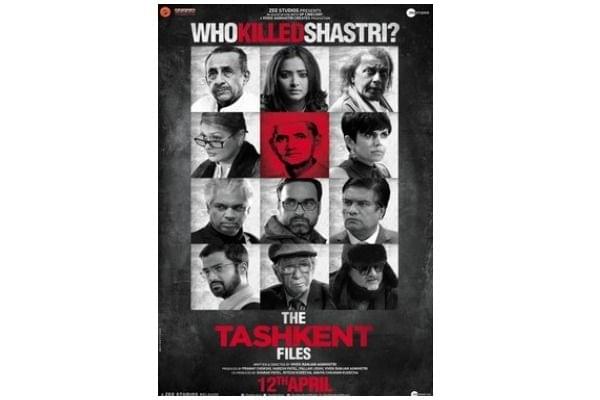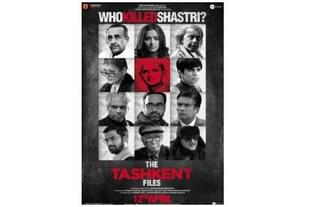Culture
Variables in ‘The Tashkent Files’, ‘Sleeper Hit’ Of The Year
Sujata Srinath
May 17, 2019, 06:17 PM | Updated 06:17 PM IST
Save & read from anywhere!
Bookmark stories for easy access on any device or the Swarajya app.


Vivek Agnihotri’s movie, The Taskent Files, is still going strong in its sixth week. In a genre that is neither documentary nor a retelling of a historical event, this movie fulfills the yearning of a ‘thinking’ audience that is interested to seek the truth behind many suppressed historical events in new India’s not-so-distant past.
Shefali Vaidya, who has written a review of the film tweeted this on 14 May:
Wow @vivekagnihotri congrats The Tashkent Files Box Office: Emerges As A Superhit By Surpassing The Profit % Of Kesari, Gully Boy & Luka Chuppi! https://t.co/XCSOLFgG1u
— Shefali Vaidya à®·à¯à®à®ªà®¾à®²à®¿ வà¯à®¤à¯à®¯à®¾ शà¥à¤«à¤¾à¤²à¥ वà¥à¤¦à¥à¤¯ (@ShefVaidya) May 14, 2019
Even Anurag Kashyap had this to say:
Whatever you say you cant take away from the fact that âTaskent files is the bonafide sleeper hit of the year. Personal prejudices aside. https://t.co/ZahcwVLtz9
— Anurag Kashyap (@anuragkashyap72) May 10, 2019
And of course, Vivek Agnihotri is over the top with the success of his film:
Fourth week Triumph! Peopleâs film, âThe Tashkent Filesâ remains rock-steady; roaring #RightToTruth! https://t.co/QIZgenGfFG
— Vivek Ranjan Agnihotri (@vivekagnihotri) May 11, 2019
I watched the film a month back, when it was not too certain how the movie would fare in the box-office. I tried getting tickets for 18 April thinking it would be a nice way to end a most successful voting day for me—for the first time my entire family voted and I suspect we voted for the same party, although my offspring did not want to divulge to whom they cast their vote, since, “I thought it was a secret ballot, Amma!”
But of course, that did not materialise, as the only available seats were in the first two rows right in front of the screen and my husband refused to watch the movie that closely. So I tried to book for the week-end and found to my dismay that the movie was not being screened at any of the multiplexes close to my home. Disappointed, I resigned myself to watching the movie on TV whenever that would happen.
Later that week I saw a tweet from Vivek Agnihotri urging folks to force the multiplexes to screen his movie and so, I decided to try my luck again. Lo and behold, the Gopalan multiplex near home was screening the movie at the 10 pm slot. Quickly I booked two tickets in the B row. Okay, not so quickly, as I am not a millennial so it takes me time to figure out what to press to get the booking done on my oh-so-smart phone but still, I got it done all by myself and I consider that great progress in overcoming the label of being technology-challenged.
Come Sunday night and my husband and I sailed forth to watch the movie. I checked and rechecked my phone to make sure I knew exactly where the ticket barcode was hidden so that I did not fumble when asked at the theatre entrance. When we got through that hurdle, we sat for a while in the foyer because we were way too early—I can almost hear my girls snigger—and were pleasantly surprised to see the crowd build up.
Now for the movie. The lead actress, Shweta Basu Prasad, portraying the ‘fake news’, wannabe, political journalist, Ragini Phule, was a clever character choice that Agnihotri has scripted. It gave him a leeway to convey what he thought about such beings and allowed him to express his hope of them evolving into becoming true to their profession by actually searching for the truth behind any story.
In fact, the fictional script of a young journo desperately looking for a scoop without “giving a damn” about its authenticity and then getting more and more involved as the truth behind the story begins to get to her core, awakening her innate sense of justice, is a brilliant setting. It reminded me of the plot of Avarana – The Veil, a Kannada novel written by S L Byrappa and translated beautifully by Sandeep Balakrishna, where historical facts that have long been suppressed are revealed in a wholly fictional setting.
Similarly, not only the young journalist, even the rest of the characters around her are all fictional—the politicians are cast in such a way that it is not immediately obvious which character represents which current-day politician but then that was not what Vivek Agnihotri was trying to do anyway. It was almost as if he was using the characters as representative variables to give us an idea of the general ecosystem where certain events of great importance are suppressed and hidden from public view for a whole lot of complicated reasons, not the least one being to grab and remain in power.
The Variables
The historian variable is played by Pallavi Joshi. She plays the distorian as Arun Shourie famously called them, one who firmly believes that she has the facts and anything that she doesn’t certify is just fiction. The scene where she realises that her authority on history is being powerfully challenged is one that remains with me…that trembling chin and the glint of tears in her eyes where you can almost see her ego being battered.
The Opposition variable is played to a hyperbole by Mithun da, the straggly hair and the dhothi-jubba a perfect foil to the incredibly sweet smile that is revealed at the very end when he welcomes the young ‘fake’ journo into the world of politics! The NGO variable is played by Mandira Bedi, her character’s name as Indira Joseph Roy curiously echoing Arundathi Suzanne Roy’s name, and I am sure that is just a coincidence. I found the way she draped her saree fascinating and the tension between the ‘distorian’ and this NGO lady was palpable in many of the scenes.
The right-wing variable is played by Pankaj Tripathi, whose timing for apt expressions is phenomenal. His face, when he is accused of being the worst of the lot, for being a racist for persisting on dwelling on the name of the cook who served Shastriji’s final meal, is a study in rage and restraint.
Prakash Belavadi fills in the RAW variable while Rajesh Sharma acts out the Intelligence Bureau variable. Both of them were included to show how compromised the intelligence apparatus was—they knew a lot but they could not reveal for fear of their jobs and/or their lives.
Naseerudin Shah played out the oily politician variable wearing a veshti, reminding us of someone familiar.
After all the nit-picking
The plot could have been scripted tighter, the shots of the meeting room where the enquiry commission sat for deliberation could have been a little brighter, Mithun da could have been a little more muted, Ragini Phule’s character could have been fleshed out a little more. One can go on in this vein finding these nit-picking faults and taking nasty jibes at Agnihotri for using the movie to air his pet peeves but the fact of the matter is that the objective of the movie is not to mesmerize with the theatricals or the technology nor to force a narrative but to wake up the audience to seek certain truths about our second Prime Minister’s death. The Tashkent Files is a thinker’s movie—was our prime minister Shastri killed in Tashkent?
I walked away from the theatre feeling blessed that such a movie was running to almost packed houses in the third week of its release. Our country is not only Gandhi’s and Nehru’s. It is Shastriji’s too. We need to know what happened to him in Tashkent. And it is time to bring him back into our nation’s collective narrative, to remember him for who he was and what he stood for. Jai Jawan, Jai Kisan!




